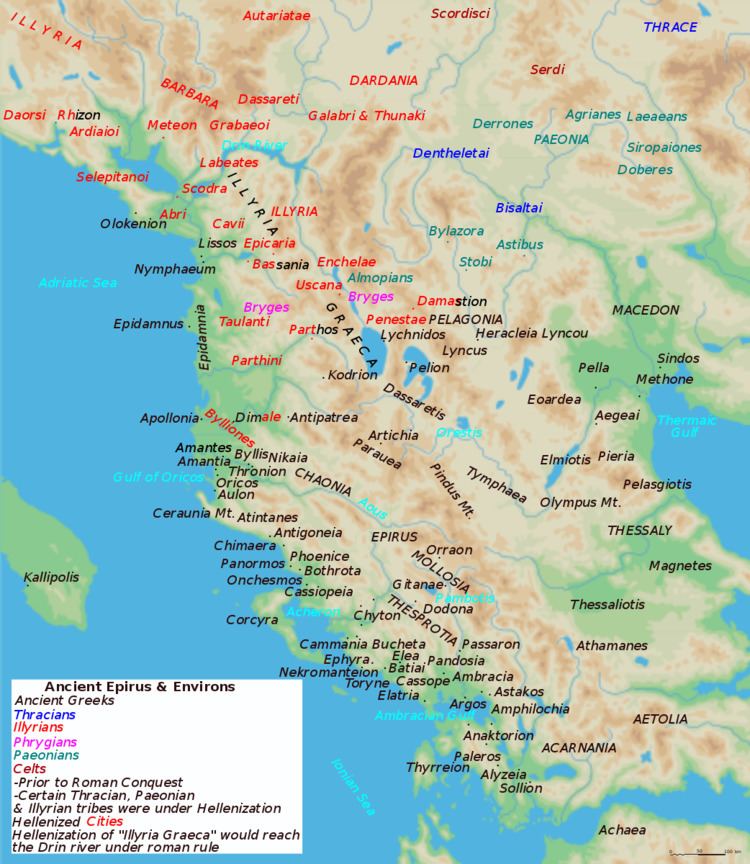 | ||
Similar Atintanians, Autariatae, Illyrians | ||
The Chaonians (Greek: Χάονες, Chaones) were an ancient Greek tribe that inhabited the region of Epirus located in the north-west of modern Greece and southern Albania. On their southern frontier lay another Epirote kingdom, that of the Molossians, to their southwest stood the kingdom of the Thesprotians, and to their north lived the Illyrian tribes. According to Virgil, Chaon was the eponymous ancestor of the Chaonians. By the 5th century BC, they had conquered and combined to a large degree with the neighboring Thesprotians and Molossians. The Chaonians were part of the Epirote League until 170 BC when their territory was annexed by the Roman Republic.
Contents
Descriptions by ancient writers
According to Strabo, the Chaonians (along with the Molossians) were the most famous among the fourteen tribes of Epirus, because they once ruled over the whole of Epirus. The Illyrians occupied the coastal and hinterland regions further north; however, the Periplus of Pseudo-Scylax makes a clear distinction between the Chaonians and the Illyrian tribes. The Illyrians and Chaonians appear to have had — at least at times — a confrontational relationship; Polybius recounts a devastating raid mounted in 230 BC by the Illyrians against Phoenice, the chief city of the Chaonians. The incident had major political ramifications. Many Italian traders who were in the town at the time of the sacking were killed or enslaved by the Illyrians, prompting the Roman Republic to launch the first of the two Illyrian Wars the following year.
Political structure
The Chaonians were settled Kata Komas (Greek: Κατά Κώμας) meaning in a collection of villages and not in an organized polis (despite the fact that they called their community a polis) and were a tribal state in the 5th century BC. Aristophanes had used the name of the tribe as a pun to illustrate the chaos of Athenian foreign policy. According to Thucydides, their leaders were chosen on an annual basis; he names two such leaders, Photius and Nikanor "from the ruling lineage". In the 4th century BC, the Chaonians adopted the term prostates (Greek: Προστάτης, "ruler") to describe their leaders, like most Greek tribal states at the time. Other terms for office were grammateus (Greek: Γραμματεύς, "secretary"), demiourgoi (Greek: Δημιουργοί, "creators"), hieromnemones (Greek: Ἱερομνήμονες, "of the sacred memory") and synarchontes (Greek: Συνάρχοντες, "co-rulers"). They joined the Epirote League, founded in 325/320 BC, uniting their territories with those of the Thesprotians and Molossians in a loosely federated state that became a major power in the region until it was conquered by Rome in 170 BC. During the 2nd century, the Prasaebi replaced the Chaones in their control of Buthrotum, as attested in inscriptions from that period.
Geography
Chaonia or Chaon (Ancient Greek: Χαονία or Χάων) was the name of the northwestern part of Epirus. Strabo in his Geography places Chaonia between the Ceraunian Mountains in the north and the River Thyamis in the south.
The Roman historian Appian mentions Chaonia as the southern border along with Macedon, Thrace and Thesprotia in his description and geography of the Illyrian Wars indicating that beyond these regions the Illyrians dwelled. Phoenice (Phoinike) was the capital and most important city of the Chaonians. The strength of the Chaonian tribes prevented the Greek city-states from establishing any colonies on the coast of Chaonia.
Mythological origins
The Chaonians claimed that their royal house was of Trojan descent, asserting ancestry through the eponymous hero Chaon (Ancient Greek: Χάων) who gave his name to Chaonia. The stories are unclear as to whether he was the friend or the brother of Helenus, the son of Priam of Troy, but in either case, he accompanied him to the court of Neoptolemus, the son of Achilles who was credited with founding the city of Buthrotum. The stories concerning Chaon's death are as unclear as that of his relationship to Helenus. Chaon was either killed in a hunting accident or offered himself as a sacrifice to the gods during an epidemic, thus saving the lives of his countrymen. In either case, when Helenus became the ruler of the country, he named a part of the kingdom after Chaon. The Chaonians' neighbours, the Molossians and Thesprotians, also asserted Trojan ancestry. It has been suggested that the very similar Chaonian origin-myth may have arisen as a response to the self-definitions of the Molossians and Thesprotians.
